Years ago, I set out on a mammoth, nine month adventure that took me from sweltering summer infernos to teeth-chatteringly frigid winters. One of the most important items on a big trip like this is a good backpack. And I didn’t want just any backpack. Nay. I wanted an ultralight, highly breathable, seam-sealed, waterproof backpack, that could handle any rainstorm that came my way, without allowing a single drop to ruin the carefully-selected gear stored inside.
I didn’t want to bother with rain covers, umbrellas, dry bags, or ruined gear. I just wanted the whole damn thing to be waterproof and not have to worry about any of that nonsense. And why not? We’ve got waterproof jackets by the billions. Is it really so difficult?
And yet…waterproof hiking backpacks remain astonishingly rare, like a four-leaf clover of the outdoor backpacking gear world. Those that do exist are so exceedingly scarce that even if you do find one, it might not be quite what you want, and then it’s back to the drawing board.
I am here to shed a little light on what a tragedy this is, because, after searching high and low throughout each and every corner of the outdoor gear world, I did indeed manage to acquire a waterproof hiking backpack. And let me tell you, it was absolutely spectacular.
The lesser-known advantages of a waterproof hiking backpack
It may not be immediately obvious, but waterproof backpacks provide a number of advantages beyond the mere fact that they’re waterproof. First, the tangential one: You don’t need to put on a rain cover, or take out an umbrella, or freak out about whether you can make it to shelter before the rain finds its way into the pack to wreak its watery havoc.
But it doesn’t stop there. Waterproof backpacks have further advantages, which actually make the pack lighter and stronger at the same time. More often than not, these packs will feature ultrasonically welded seams, which means they aren’t sewn together with a needle and thread; they use sound waves to create enough heat that two pieces of fabric can literally be fused together, without the need for sewing at all.
Welded seams provide a number of advantages, as they’re both stronger and lighter than regular seams. And, if you build the pack out of a waterproof fabric, you’ve got a waterproof backpack. It’s just that simple.
And thus, you’d have a pack that would be:
- Waterproof. Duh.
- Simpler. No worrying about whether you should grab the rain cover.
- Stronger. Welded seams are better than sewn seams.
- Lighter. You skip the rain cover; the rain cover compartment; the stitching; the additional overlapping fabric required for the stitching; the internal binding that protects the stitching; and an internal waterproof bag for protecting electronics.
That last one is actually quite a big deal. Depending on the design of the product, welded seams can reduce the weight by up to 30%. In a world of ultralight minimalism, it seems bizarre to me that waterproof construction hasn’t replaced tradition methods in an effort to minimize the weight of the pack. Not all the time, as certain circumstances would conflict with other design elements, but when it’s possible to do so, well…why not?
When would you not want a waterproof backpack?
Now I’ll admit that in some cases, it doesn’t make sense to go to these lengths to achieve waterproof, or at least rainproof, construction. Many backpacks (though not enough) make use of full-length zippers, which allow them to open like a suitcase, and the direction of the seam makes it something of a challenge to ensure the pack is waterproof. In cases like these, it’s a lot easier to use a rain cover. Fair enough.
But if it’s a top-loader, there’s simply no excuse:
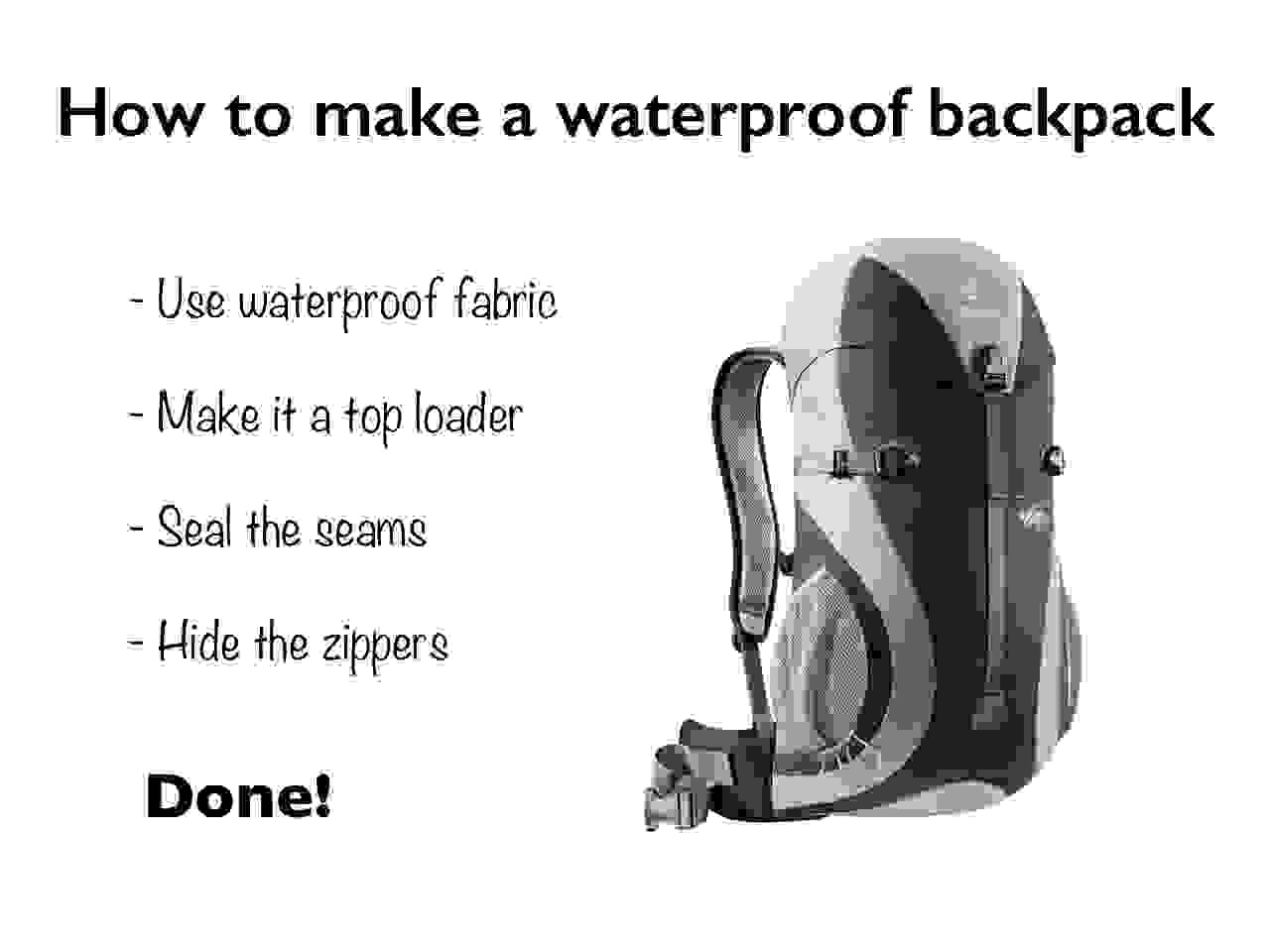
It’s really just that simple.
The specific pack pictured above is the Deuter DS20, which no longer exists. Don’t worry, it wasn’t particularly comfortable anyway. But it did a number of things correctly that made me realize just how stupid the world is for not doing this more often.
Waterproof backpack concerns
These are the standard questions whenever I inform people that non-waterproof top-loading backpacks are stupid:
- Aren’t they expensive? No. See that pack pictured above? It cost a mere $130, and I got it for about $80. Although it’s true that waterproof construction is more expensive to manufacture, this is generally offset by the fact that companies will simply reduce the number of seams to a bare minimum, which is what they should have been doing anyway. Half the seams on most packs are useless, and serve no other function than a fashion statement, and you can cut down on costs by skipping them. And the fabric itself isn’t prohibitively expensive either. Plus you don’t need to buy a rain cover or a dry bag, which means even if it is more expensive, it might not matter.
- Are they more fragile? No. In the case of the pack shown above, the waterproof membrane was actually between two nylon layers, thus creating an exquisitely durable, but also rather normal-looking, waterproof backpack. It was actually tougher than most regular backpacks I’ve used, as it simply featured a better exterior fabric.
“But…but…there must be something!!!!!”
No. Have you ever been in a hiking or camping store and looked at the massive ocean of waterproof jackets available for maybe $100 each? Well, they could just make a pack out of it. Except it would be even cheaper, since those jackets are waterproof and breathable, whereas a pack only needs to be waterproof.
So where are they!?!?!?
I’ve always wondered if the problem was just an up-sell thing; backpacks are absurdly labor-intensive products, yet they might only cost $200, even for a big one. So what’s a good way to increase profit margins on a low-margin product? Up-sell a customer with a high-margin add-on, like a rain cover. They’re just a garbage bag with an elastic band, but they might cost up to $40. That would be hugely profitable.
But then these companies sell backpacks with included rain covers, often at the same price of those that don’t, so I can only imagine that it’s just out of sheer stupidity.
Okay, I know I’m being a little mean, but again, why the hell not? Most outdoor backpacks are top-loaders (which is annoying, but oh well), meaning all they’d need is a waterproof fabric. They wouldn’t even need the welded seams. But quite a few companies use welded seams anyway, but somehow forgo them completely when it comes to backpacks. Come on, guys! Get it together!
Waterproof backpacks that actually exist!
Okay, so a few examples do exist, but it’s astonishingly challenging to track them down. The vast majority of these are small, roll-top backpacks intended for bikers, or maybe kayakers and so on. Some are the type you can actually submerge, though this is less important for hiking, so I won’t go into detail about which is which. Just don’t jump in a lake.
And, in case it’s somewhat ambiguous, this list is not meant as an endorsement; some of these may not work for hiking or traveling, but part of the reason I’m including them is to highlight the rarity of a suitable waterproof hiking backpack to begin with. So this list is by no means comprehensive, nor is it intended as a collection of perfect solutions; just potential options:
Arcteryx Arrakis Pack
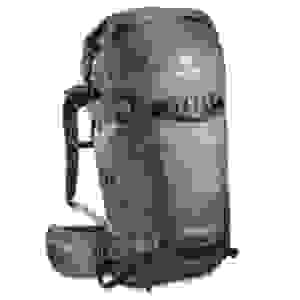
This is one of the extraordinarily few waterproof hiking packs anywhere to be found. It has many of the features that a standard hiking backpack would include, particularly the seriously padded and adjustable straps, which are practically nonexistent in others.
On the downside, it puts a “waterproof” zipper right on top of the bag, which is the stupidest place in the world to put a zipper of any sort. The rain hits right at the top at the highest possible velocity, and “waterproof zippers” seem to be about as imaginary as a unicorn.
But aside from that, it might actually be the only real option you’re able to find. It’s probably going to be a whole lot more comfortable than most other waterproof backpacks, and it has fairly good features as well.
Sadly, it costs $500. But you can get it here.
Sea to Summit Flow 35L DryPack

This one’s another semi-real hiking pack with decent features, including exterior organization, which, for some reason, is exceedingly rare in these types of packs, and I can’t understand why.
On the downside, I think Sea to Summit could have done a little better with this one. See the dark grey thing on the side? That’s a side pocket. And it looks laughably incapable of securely holding a large water bottle. Seriously, what is it with these outdoor companies and their hydrophobia? Where else does a water bottle go?!?!?!
Plus they’ve got loops to attach a bungee cord, but…no bungee cord. Um…okay? Plus they’ve got an exterior zippered pocket, but…I don’t think the zipper is even water-resistant. I could be wrong about this, but it looks normal, and they don’t claim otherwise. I can’t sigh hard enough to convey my annoyance.
And it’s so…bulbous. Is there really any reason for a pack this size to jut away from your torso this much? I mean, I know the compression straps are there to fix the problem, but why include the problem to begin with?
On the upside, it’s got some serious shoulder and hip straps. It’ll work well. Except for all those weird problems.
Get it here.
SealLine Urban Backpack
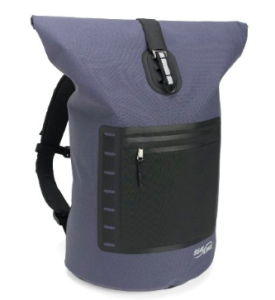
And just like that, we’re already moving away from “you could use this for hiking” and into “this is basically all there is.”
This is the standard format for most waterproof backpacks: Roll-top closure, with minimal exterior adornments. It works, but it limits how conveniently you’re able to find specific items. But if you’ve been using top-loading backpacks this whole time anyway (and most people do, since those are often the only option), then this isn’t much different.
It comes in quite a few colors, and multiple sizes. The larger of the two is right around the ideal size for traveling or longer hikes, though again, the lack of exterior features can be limiting. The back is quite nicely padded, though.
You can get it here.
Ortlieb Velocity Backpack
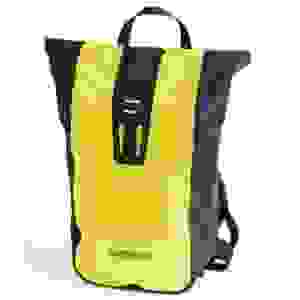
Once again, a roll-top backpack with minimal exterior features, mainly designed for bikers. But it’ll work.
This is smaller than the others, sized to be a daily commuter pack, which would work fairly well as a daypack for hiking or similar activities.
It has no exterior pockets, but includes a couple attachment points for those who like to strap things to the outside.
It’s probably more suitable for everyday use, for students, or short hikes and other sorts of things, rather than something that could pass for a “hiking pack,” which would probably require something bigger, and with more features.
Get it here.
Timbuk2 Especial Vuelo Backpack
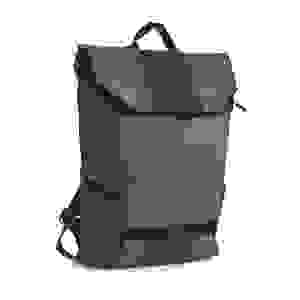
This one’s pretty cool. Built by the cycling-focused Timbuk2, and featuring a flap closure and a roll-top closure, in case you want even more protection, this is a good pack for cycling, and it can be used quite easily for day hikes or random everyday gear hauling as well.
I also think it looks quite nice for city use, rather than resembling a hiking pack or a kayak roll-top dry pack.
Features include two exterior side pockets, a zippered pocket, an internal organizational panel, and a laptop sleeve. The side pockets look a little too small for really big water bottles, but if the main chamber is under-filled, it’ll probably be just fine. There’s a removable sternum strap and waist strap, and its 25 liter capacity isn’t bad for day hikes or city jaunts.
Get it here.
Caveats!
I wish I had a few more decent recommendations, but options are few and far between. This is especially true for hiking packs, which is why I fell so quickly into discussion of related items, many of which tend to be somewhat similar to each other, which is why I didn’t want to spend too much time on them.
I can only conclude that backpack manufacturers are just plain lazy, or that hikers just don’t bother hiking in the rain often enough to complain about this. Though again, it’s really just top-loaders that could do this, and I think exclusive top-loaders are dumb. But most hiking backpacks are top-loaders, which means not making them waterproof is dumb.
I find this especially annoying in the case of companies that did make waterproof backpacks (Deuter, Vaude), but don’t seem to bother anymore, or companies that currently do (Arcteryx), but only one or two that cost $500, or companies that make millions of waterproof jackets but not waterproof backpacks. Sigh.
Maybe someday. But in the meantime…try to make do with a rain cover. Things could be worse.




This is when you’d want to go with something like the Arc Zip or Haul by ZPacks – http://www.zpacks.com/backpacks.shtml. Hyperlite Mountain Gear also makes cuben packs. You just need to understand the limitations of the material – doesn’t handle abrasion well. Very light, very expensive. Lots of great reviews on BackpackingLight.
Now that I’m 75 I don’t go backpacking very often. The last time was two years ago when I spent a month walking the Camino de Santiago. For that I used the Terra Nova Laser 20L Elite: http://bit.ly/1Uluzub
It has a very simple harness, no padding on the back, a hipbelt of sorts, a chest strap and two side mesh pockets. It remained perfectly dry in heavy rain, comfortable for 6-7 hours’ walking each day, survived the trip without a scratch, and weighed just 210g. True, my total load was only 3098g plus food for lunch, but that was everything I needed. And there are quite a few other lightweight waterproof rucksacks, but without all the bells and whistles. Perhaps the answer is to cut down on the weight we try to carry.
Oh boy, On my quest to find a reasonable waterproof backpack for my motorcycling-hiking-city-combo I’ve been having many of your thoughts.
WHY can’t everybody just put some mesh side pockets on their bags? Not that I need this when motorcycling but when hiking or doing a city trip I always put my bottles there. There would be many backpacks of interest to me IF they had this! E.g. the Ortlieb packman pro 2…
WHY does nobody ever think of hydration system compatibility? I think in many activities where you would expect to see waterproof backpacks the use of hydration systems is VERY common, be it cycling, hiking, motorcycling… It’s nice that Ortlieb puts a sealed port for your hose, but then everytime I want to remove the hose I first have to remove either the mouthpiece or the connector to the bladder, duh! Can’t you just put a hydration compartment between the main compartment and the back cushioning?
I found an interesting option. It’s the Alpinestars Orbit. It has a 28-35L waterproof main compartment (extendable through a zipper), does have an extra compartment for a hydration system (big plus) and some inside and outside organisation.
Inside: removable organizer to hold laptop, tablet, phone, etc… while it seems like a good idea I am not fond of this. I prefer just to have a sleeve on the back for a laptop. And I would love to have at least one zippered small compartment in the waterproof compartment to put things like wallet and passport. That’s a fail here for me.
Outside: front mesh pocket (love it!), bungee cord on top of that mesh (like it), two small zipped compartments versus the front top (I like this for little things that can get wet), stuffaway straps on the bottom (nice too for putting a jacket or a sleeping mat…), AND it has two sidepockets which are… no, NOT mesh, ARGHHH! I don’t mind having those sidepockets but they have two design flaws based on which I am still considering sending it back: It’s only a oneway zipper, while I might fit a small 0,5L bottle in there anything else is to long and I can’t “fix” it with a twoway zipper. Also, the lower compression straps are attached to the cover/flap of those sidepockets, so I can’t even use those compression straps to fix a bottle and at the same time loosing backpack compression if that sidepocket is not closed. Comeon, just gibe me MESH side pockets.
Since I can’t live without hydration compatibility I will have to stick to either this bag or choose something like the Ortlieb Track… I love the functionality of my Osprey escapist but it’s damn 100% not waterproof!
I’m just glad I’m not the only one who can’t understand why it’s so hard to make a really functional backpack….
Best,
Phil
Yeah, I don’t understand what the challenge is. People say things like “oh, but that would be really expensive,” for some reason forgetting that Columbia makes a million rain jackets for $60 that work just fine. Sigh.
Well, and even if a decent backpack costs around 120$ it’s woth the price….
Just ordered some from Mountain Equipment, seems like it has (almost) everything I need, maybe I would need a bit tougher materials for motorcycling but well, I guess I can’t have the cake and eat it too ?
So I ordered some backpacks from Mountain Hardware to examine. Those are really nice backpacks! So here’s my little summary (based on what my expectations are for are rucksack to suit my needs).
First, they all have mesh side pockets (thank you MH), they are all hydration system compatible (thanks again), all have a front mesh pocket as well, all have a hipbelt and a whistle on the sternum strap, and all feature the same ventilation system on the back (which is of a type I really like). Also, they are all lightweight and really compact when empty, the latter I like if I don’t want to carry it on my back and put it on top of my motorcycle dryback whithout adding any bulk to it.
Rainshadow 26
Lightweight and nice bag, seems just like the right size for my needs. It also has one little inside pocket in the main compartment which is padded and has a key hook. It has a zippered top loader closure with a storm flap, so I’m not sure if this will be really waterproof when riding motorcycle. Even though I usually prefer a zippered closure, it seems to get stuck a bit when trying to close and I have to put the storm flap over the zip manually after closing the zips. I wish they had added the small cushions with pockets on the waist belt as seen on the other bags.
Rainshadow 36
Almost everything I said about the 26L version applies here as well. The only difference being (besides the obvious fact that is is larger, too large for my needs) is that is has a second inside pocked (non flexible mesh) and the cushion and pockets on the waist belt, also the waist belt can be stowed away (goes inside the hydration sleeve). This bag is too large for me, even though I like the two additions compared to the 26.
Scrambler 35 RT
This one has roll top closure, so from a waterproof point of view this is better. Also the outside material is a bit tougher than on the Rainshadows, though it is still a lightweight rucksack. It has daisychains that go along the sides of the front mesh pocked, they are hidden by a flap. Even though it’s only one liter smaller than the Rainshadow 36 it feels more compact on my back, maybe it’s because you can use the rolltop to release air from the inside and compress it like this. It has the same padded and stowaway hipbelt. When the bag is only half filled or less, the front mesh pocket stays open (how to explain, the top edge of the mesh pocket edge does not touch the backpack). Things might fall out and it looks a bit strange as well. Even though I like this bag because it’s large but still compact, seems sturdier for backcountry montorcycling and is really waterproof it has one mature drawback: it does not feature even a single interior pocket. I really wish it had, because I just want that to store my wallet and passport protected from the elements.
Why didn’ I look at the Scrambler 30? It does not have a front mesh pocket, it does not have interior pockets and I’m not that much fond of having a traditional top flap design (not sure how this is really called).
My choice will boil down to either the Rainshadow 26 or the Scrambler RT 35, tendency being the Scrambler. I will put it in the shower to see, how well the zippered close is waterproofed.
While those backpacks are not perfect for my ideas of designing a backpack, they are pretty damn close! Thank you Mountain Hardware! And thanks to snarkynomad for this article and the people that mentioned the MH backpacks in the comments!
So happy I stumbled on this, fantastically written and couldn’t agree more!
I made a 2500km trip with the Archteryx Naos 70 on my back. It was a waterproof rucksack with a very good quality. I bought it in 2008. Now it ist old and I have to repair it.
Archteryx does not have any waterproof 70-liter backpack and it seams, that they are realy rare. I found the Klättermusen Arvaker 60L (it ist not waterproof, but nearly – and I know, that that’s not exactly, what I am looking for) and the Load Limo from Aarnpacks .
http://www.klattermusen.com/packs-and-gear/arvaker-backpack-60l-ebony
http://www.aarnpacks.com/#!load-limo/ci5c
Arcteryx has two waterproof bags in the leaf series: drybag70 and 40. The best looking waterproof packs ever!
An I forgott the crux:
https://www.crux.uk.com/shop/alpine-rucksacks
Yes, as of 2015, Mountain hardware now makes a ton of waterproof backpacking bags, I definitely like the Mountain Hardwear Scrambler RT 40 OutDry Backpack, mainly because its main storage area is waterproof and it has an exterior water bladder insert for quick access, as well as side mesh bottle pockets and a large front mesh pocket for drying out gear or for waterproof gear like a waterproof solar charger, knife, tools, etc
Exped Serac and Black Ice, though more climbing focused
I know this post is quite old, but for those still looking for waterproof rucksacks, take a look at Fjallraven.
http://www.fjallraven.co.uk/bergen-605
I cycle 20 miles a day in the UK, where is rains a lot, and my stuff has always been dry! It is super adjustable, and really well designed